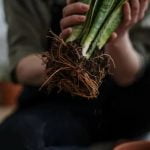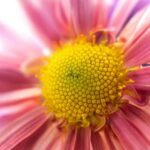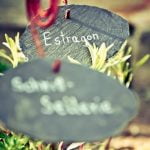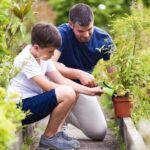Potted gardening offers a world of creative possibilities for both novice and seasoned gardeners alike. Whether you have limited outdoor space, want to add greenery indoors, or simply enjoy the flexibility of moving your plants around, potted gardening ideas are a fantastic way to cultivate your own little oasis. In this article, we will explore the ins and outs of potted gardening, from choosing the right pots to selecting the best plants and designing beautiful arrangements.
The beauty of potted gardening lies in its convenience, accessibility, and versatility. With just a few containers and some soil, you can transform any corner of your home into a vibrant garden.
Whether you prefer flowers that bloom all year round, fragrant herbs for culinary creations, or fresh vegetables for your kitchen, potted gardening allows you to bring nature closer to you wherever you may be. The possibilities are endless when it comes to creating unique and personalized green spaces through potted gardening.
In this guide, we will delve into the benefits of potted gardening and provide practical tips on how to successfully cultivate plants in pots. From choosing the right size and material for your containers to mastering essential maintenance techniques like watering and fertilizing, we will equip you with all the knowledge you need to create thriving potted gardens. So whether you’re a beginner looking to dip your toes into gardening or a seasoned pro seeking new inspiration, join.
Benefits of Potted Gardening
Potted gardening offers a multitude of benefits, making it a popular choice for both experienced gardeners and beginners alike. One of the main advantages of potted gardening is its convenience. With potted plants, you have the flexibility to move them around to different locations based on sunlight requirements, temperature changes, or simply for aesthetic purposes. This convenience allows you to create the ideal growing conditions for your plants without being restricted by garden bed locations.
In addition to convenience, potted gardening also offers accessibility. For individuals with limited space, such as apartment dwellers or those with small yards, potted gardening provides an opportunity to still enjoy growing plants without the need for a traditional garden plot. Even those with physical limitations can benefit from potted gardening by having their plants easily within reach for watering, pruning, and harvesting.
Furthermore, potted gardening provides versatility in design and arrangement options. You can mix and match different types of pots to create unique displays that reflect your personal style and preferences. Whether you prefer a uniform look with matching pots or a more eclectic vibe with various sizes and shapes, the possibilities are endless.
Additionally, you can experiment with vertical gardens using hanging planters or tiered displays for added visual interest in your outdoor or indoor spaces. With potted gardening, you have the freedom to unleash your creativity and showcase your green thumb in a dynamic way that suits your individual needs and tastes.
Choosing the Right Pots for Your Plants
Potted gardening is a fantastic way to bring greenery and life into any space, whether you have a backyard, balcony, or just a windowsill. When it comes to choosing the right pots for your plants, there are several factors to consider to ensure the health and growth of your green friends.
One of the most important aspects is the size of the pot. Plants need room for their roots to spread out and grow, so selecting pots that are appropriately sized for each plant is essential.
In addition to size, the material of the pots can also impact the well-being of your plants. Terracotta pots are porous and allow for better airflow and drainage, making them ideal for plants that prefer drier soil. On the other hand, plastic pots retain moisture well and are lightweight, which can be beneficial for plants that require more frequent watering. It’s important to match the material of the pot with the needs of your specific plants.
Lastly, proper drainage is crucial for potted garden success. Without adequate drainage holes in the bottom of your pots, excess water can accumulate and lead to root rot or other plant diseases.
Ensure that each pot has sufficient drainage by either selecting pots with pre-drilled holes or adding your own before planting. By paying attention to size, material, and drainage when choosing pots for your plants, you’ll set yourself up for a thriving potted garden filled with healthy and happy plants.
| Aspect | Consideration |
|---|---|
| Pot Size | Select appropriate sizes based on plant’s root system |
| Pot Material | Choose terracotta for better airflow or plastic for moisture retention |
| Drainage | Ensure proper drainage holes prevent water accumulation |
Essential Tools and Supplies for Successful Potted Gardening
When it comes to successful potted gardening, having the right tools and supplies can make all the difference in nurturing healthy and thriving plants. From basic essentials to specialized equipment, having a well-stocked arsenal can ensure that your potted garden flourishes. Here are some key items that every potted gardener should have:
Garden Gloves
Protecting your hands while tending to your plants is essential, especially when dealing with prickly or thorny varieties. Invest in a sturdy pair of garden gloves to keep your hands safe from scratches, cuts, or irritation while working in your potted garden.
Trowel and Hand Tools
Having a reliable trowel and set of hand tools is crucial for planting, transplanting, and maintaining your potted plants. Look for ergonomic designs that fit comfortably in your hand and provide easy maneuverability for precise gardening tasks.
Plant Food and Fertilizers
To support optimal plant growth and blooming, incorporating plant food and fertilizers into your potted gardening routine is essential. Choose products formulated specifically for container plants to ensure they receive the necessary nutrients for robust development.
Watering Can or Hose
Proper hydration is key to the health of your potted plants, so having a reliable watering can or hose is vital for keeping them hydrated. Make sure to water consistently but avoid overwatering by checking the soil moisture levels regularly.
With these essential tools and supplies on hand, you’ll be well-equipped to embark on your potted gardening journey successfully. Whether you’re a seasoned gardener looking for new challenges or a beginner eager to explore the world of container gardening, having the right equipment at your disposal can enhance the joy and satisfaction of cultivating a beautiful potted garden filled with lush foliage and vibrant blooms.
Best Plants for Potted Gardening
Potted gardening offers a wide array of plant options to choose from, depending on your preference and the environment you are working with. When selecting plants for your potted garden, it is essential to consider factors such as sunlight exposure, space availability, and care requirements. Here, we’ll explore some of the best plants for potted gardening, including flowers, herbs, vegetables, and succulents.
Flowers are popular choices for potted gardens due to their vibrant colors and ability to brighten up any space. Some excellent flowering plants for pots include petunias, marigolds, pansies, and begonias. These colorful blooms can add a cheerful touch to your outdoor or indoor setting and require minimal maintenance to thrive.
Herbs are another fantastic option for potted gardening as they not only provide fresh flavors for cooking but also release delightful fragrances. Basil, rosemary, mint, and parsley are just a few examples of herbs that grow well in containers. With proper care and attention to sunlight and watering needs, you can have a thriving herb garden right at your fingertips.
When it comes to vegetables in potted gardens, options like tomatoes, peppers, lettuce, and radishes are ideal choices. Container vegetable gardening allows you to grow your produce even in limited spaces like balconies or patios. Just ensure that your vegetable plants receive adequate sunlight and nutrients for healthy growth. Incorporating a variety of vegetables can also make your potted garden visually appealing while providing you with fresh produce at arm’s reach.
| Plant Type | Examples |
|---|---|
| Flowers | Petunias, Marigolds, Pansies |
| Herbs | Basil, Rosemary, Mint |
| Vegetables | Tomatoes, Peppers, Lettuce |
Designing Your Potted Garden
When it comes to potted gardening, the design of your arrangement can truly make a difference in the overall visual appeal of your space. One key aspect to consider is the color scheme of your potted garden. Choosing plants with complementary colors can create a harmonious and visually pleasing display. For example, pairing cool-toned plants like lavender and blue with warm-toned plants like marigolds and orange zinnias can create a striking contrast.
Arranging your pots in an aesthetically pleasing way can also elevate the look of your potted garden. Experiment with different heights by using plant stands or placing taller plants towards the back of your arrangement. Grouping pots in odd numbers can create a sense of balance and symmetry. Additionally, consider incorporating various textures and leaf shapes to add interest to your display.
A great way to enhance the aesthetics of your potted garden is by selecting pots that not only complement your plants but also suit the overall style of your outdoor or indoor space. Choose pots in materials like terracotta, ceramic, or metal that reflect the theme you want to achieve.
Don’t forget to take into account the size of your plants and their root systems when selecting pots – larger plants will need bigger pots with proper drainage holes for optimal growth. With these design tips in mind, you can create a beautiful and cohesive potted garden that brings joy and beauty to any environment.
Maintenance Tips
Maintaining your potted garden is essential to ensure the health and beauty of your plants. Proper watering, fertilizing, pruning, and pest control are key aspects of keeping your plants thriving. Here are some tips to help you successfully maintain your potted garden:
- Watering: One of the most important aspects of maintaining a potted garden is proper watering. Make sure to water your plants consistently but be mindful not to overwater. The frequency of watering will depend on the type of plant, soil, and weather conditions. Consider investing in self-watering pots or moisture meters to help gauge when your plants need water.
- Fertilizing: Providing nutrients to your plants is crucial for their growth and overall health. Choose a balanced fertilizer specifically designed for potted plants and follow the instructions on the packaging. Fertilize your plants during their growing season, typically in spring and summer, but be careful not to over-fertilize as this can harm your plants.
- Pruning: Regular pruning helps promote new growth, maintain shape, and prevent disease in your potted garden. Remove dead or damaged leaves, flowers, or stems with clean pruning shears or scissors. Prune your plants as needed based on their specific care requirements.
- Pest Control: Keep an eye out for common pests that may infest your potted garden such as aphids, mealybugs, or spider mites. Inspect your plants regularly for any signs of pest damage like yellowing leaves or sticky residue. Consider using natural remedies like neem oil or insecticidal soap to control pests without harming beneficial insects.
By following these maintenance tips for watering, fertilizing, pruning, and pest control in your potted garden, you can enjoy a flourishing and healthy collection of plants throughout the year. Remember that each plant has its own specific needs so it’s important to research and understand how to best care for them in a container setting. Taking proper care of your potted garden will reward you with beautiful blooms, delicious produce, or calming greenery to enhance any space.
Whether you’re new to potted gardening ideas or have been cultivating container plants for years, there’s always room for creativity when it comes to maintenance tasks in a small space. Experiment with different watering schedules or organic fertilizers to see what works best for your plant babies. Don’t forget that pruning can also be an opportunity to shape your shrubs into topiaries or simply trim back unruly foliage for a neat appearance.
Creative Potted Gardening Ideas
Potted gardening offers endless possibilities for creativity and innovation, especially when it comes to design ideas. One popular trend in potted gardening is the concept of vertical gardens. Vertical gardens involve planting in containers that are stacked or arranged vertically, creating a beautiful display that maximizes space. This is especially beneficial for those with limited gardening space or those looking to add a unique focal point to their outdoor or indoor areas.
Another creative potted gardening idea is tiered displays. Tiered displays involve using various heights of containers or stands to create a layered effect with your plants. This not only adds visual interest to your garden but also allows you to showcase different plants at varying levels, providing each plant with its own spotlight. Tiered displays can be achieved with shelves, plant stands, or even repurposed items like ladders or pallets.
Lastly, exploring indoor/outdoor options for potted gardening can open up a world of possibilities. Bringing your potted garden indoors can add life and greenery to your home while enhancing air quality. Selecting plants that thrive in both indoor and outdoor environments allows for easy transitions between spaces.
Additionally, utilizing hanging planters, window boxes, and balcony railings can extend your potted garden into outdoor living areas, creating a seamless connection between nature and your living spaces. Experimenting with these creative potted gardening ideas can truly transform your space into a vibrant and enchanting oasis filled with lush greenery and colorful blooms.
Conclusion
In conclusion, potted gardening is a fantastic way to bring greenery and life into your living space, no matter how small or limited it may be. The convenience, accessibility, and versatility of potted gardening make it suitable for beginners and experienced gardeners alike.
By choosing the right pots for your plants, equipping yourself with essential tools and supplies, selecting the best plants for potted gardening, and designing your potted garden with creativity and aesthetics in mind, you can create stunning displays that will enhance your surroundings.
As you embark on your potted gardening journey, remember the importance of maintenance – regular watering, fertilizing, pruning, and pest control are crucial for the health and vitality of your plants. Consider experimenting with creative ideas such as vertical gardens, tiered displays, or incorporating indoor and outdoor options to make the most out of your potted garden.
Don’t hesitate to share your potted gardening creations on social media platforms – not only will you inspire others to get started with their own projects, but you may also connect with like-minded individuals who share your passion for gardening.
So why wait? Let these potted gardening ideas spark your inspiration and creativity. Start small with a few pots on a balcony or window sill if you’re a beginner, or go all out with intricate designs if you’re feeling adventurous. Whatever path you choose to take with your potted garden, remember that the process is just as rewarding as the end result. Happy planting.
Frequently Asked Questions
How Do I Make My Container Garden Look Nice?
One way to make your container garden look nice is by paying attention to the aesthetics of your containers themselves. Choosing visually appealing pots or baskets can enhance the overall look of your garden. Also, mixing different types of plants with varying colors, textures, and heights can create a dynamic and visually interesting display.
What Are Best Vegetables to Grow in Pots?
When it comes to growing vegetables in pots, some of the best options include tomatoes, peppers, lettuce, carrots, radishes, and herbs like basil and parsley. These vegetables typically thrive in containers as long as they have enough space for their roots to grow, adequate sunlight, and proper watering.
What Are the Best Low Maintenance Outdoor Potted Plants?
For those looking for low maintenance outdoor potted plants, succulents are an excellent choice. Succulents are known for their ability to store water in their leaves and stems, making them quite resilient to drought conditions.
Other low maintenance options include lavender, ornamental grasses, and dwarf shrubs like boxwood or Japanese holly. These plants require minimal watering and care while still adding beauty to your outdoor space.

Welcome to my gardening blog! I am passionate about plants and enjoy sharing my knowledge and experiences with others. In this blog, I will write about everything related to gardening, from tips on how to get started to updates on my own garden projects.





